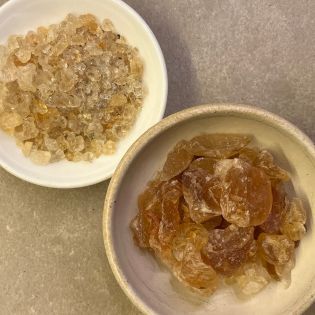Gond vs. Gond Katira

In Indian traditional kitchens and Ayurvedic remedies, Gond and Gond Katira are both widely used—but they are often mistaken for one another. Though both are edible gums with significant health benefits, they come from different plant sources, have distinct physical properties, and are used in different culinary and medicinal contexts. Understanding the difference between the two is essential, especially if you're looking to use them for specific health or seasonal purposes.
Source and Botanical Origin
- Gond, commonly referred to as edible gum, is derived from the sap of
- the Acacia tree, especially Acacia Senegal. It is a natural resin
- harvested from tree bark and is widely used in India in various sweets
- and tonics. It appears in the form of irregular, amber-colored crystals.
- Gond Katira, on the other hand, comes from the Astragalus
- species (especially Astragalus gummifer) and is mostly sourced from the
- Middle East and parts of Northern India. It is also a natural resin but
- appears as small white to pale yellow granules or flakes that swell into a
- jelly when soaked in water.
Texture and Physical Properties
- Gond is hard and crystalline in its dry form and becomes sticky and
- chewy when fried in ghee. It is commonly used in winter recipes like
- gond laddoos and panjiri because it provides warmth and energy.
- Gond Katira, however, is dry and brittle initially, but when soaked in
- water, it blooms into a soft, transparent jelly. It is used mainly
- during summers for its natural cooling effect. It is never fried and is
- always consumed after soaking.
Nutritional Content (Per 100g Approx.)
- Gond Gond
- Katira
- Calories 350
- kcal 260kcal
- Fat 0 g 0.6 g
- Carbohydrat
- es 80g 90 g
- Protein 2 g 5 g
- Fibre 0.5 g 35 g
- Gond Katira stands out due to its exceptionally high fibre content and
- mucilaginous texture, which is excellent for gut health and cooling. Gond
- (Acacia) is less fibrous but is more energy-dense, making it ideal for
- building strength and immunity.
Health Benefits and Seasonal Use
- Gond is traditionally used in winter remedies for its warming properties.
- It helps strengthen bones and joints, boosts energy and immunity,
- supports postpartum recovery, and is often included in high-calorie diets
- for children and elderly people. It is also believed to be good for
- increasing vitality and stamina.
- Gond Katira is used in summer remedies due to its powerful cooling
- effect. It helps regulate body temperature, prevents heatstroke, reduces
- internal inflammation, and supports hydration. It also aids digestion,
- improves skin health, and helps manage conditions like acidity and
- constipation due to its high fibre content.
Culinary Uses
- Gond is mostly used in cooked or fried preparations, such as laddoos,
- panjiri, and energy bars. It is typically roasted in ghee until it puffs up and
- becomes crunchy.
- Gond Katira is used in cold or room-temperature beverages and
- desserts, such as falooda, rose sherbet, and lemon drinks. It is
- always soaked overnight and never cooked or fried. Its gelatinous form
- adds texture to drinks and acts as a natural thickener.
- Though they share the same category as edible gums, Gond and Gond
- Katira are remarkably different in nature, benefits, and usage. Gond is
- your go-to in the winter for warmth, energy, and immunity, while Gond
- Katira is your summer ally for hydration, cooling, and digestion.
- Choosing the right gum based on your health goals and seasonal needs
- can significantly enhance your overall wellness. By understanding their
- unique roles, you can use each more effectively and derive maximum
- benefit from these time-tested traditional ingredients.


